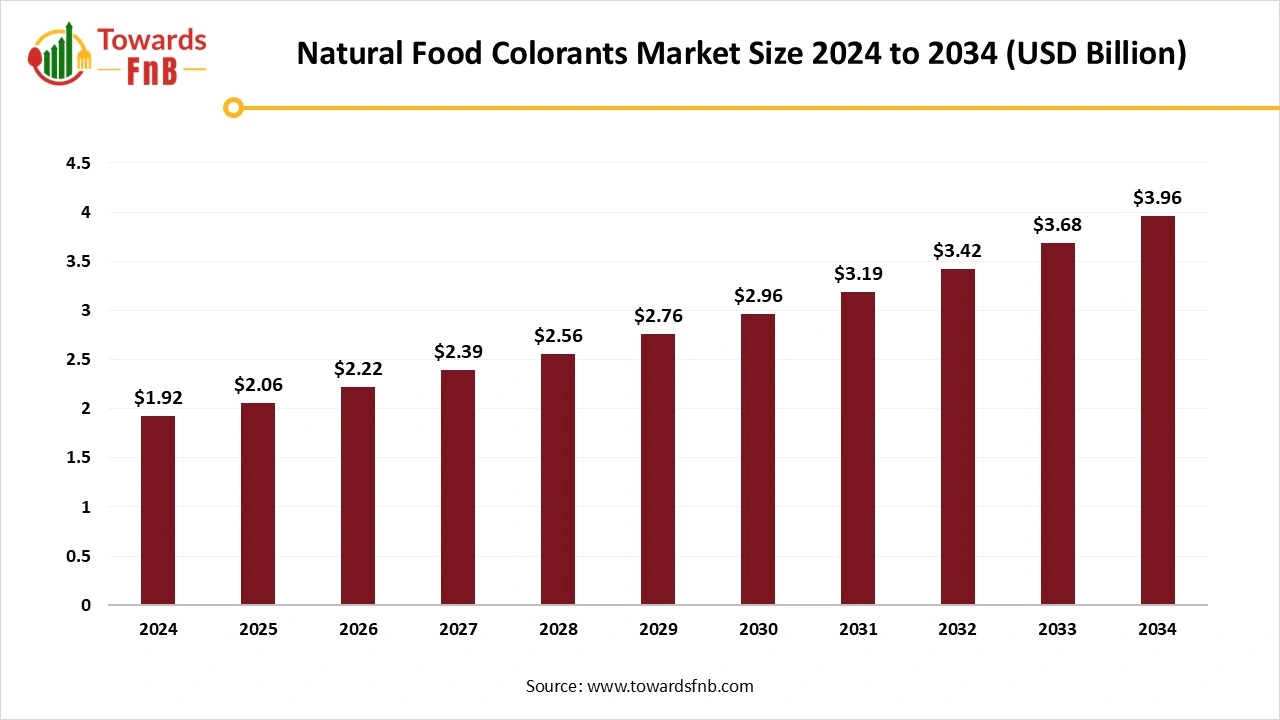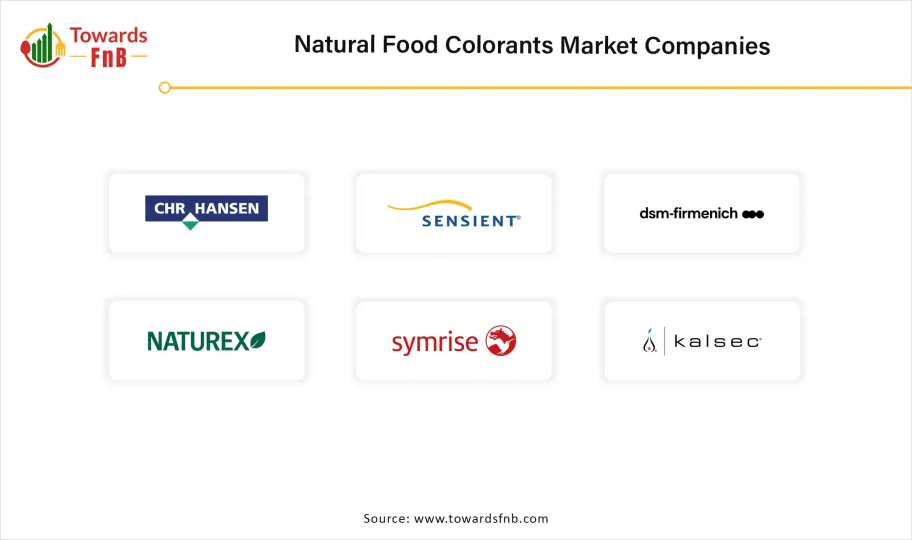December 2025
The global natural food colorants market size was calculated at USD 1.92 billion in 2024 and is expected to grow steadily from USD 2.06 billion in 2025 to reach nearly USD 3.96 billion by 2034, with a CAGR of 7.5% during the forecast period from 2025 to 2034. The rising preferences for natural and clean label products and the potential health benefits of natural colorants support the emerging demand for food colorants from natural sources.

| Study Coverage | Details |
| Growth Rate from 2025 to 2034 | CAGR of 7.5% |
| Market Size in 2025 | USD 2.06 Billion |
| Market Size in 2026 | USD 2.22 Billion |
| Market Size by 2034 | USD 3.96 Billion |
| Largest Market | Europe |
| Base Year | 2024 |
| Forecast Period | 2025 to 2034 |
| Regions Covered | North America, Europe, Asia-Pacific, Latin America, and Middle East & Africa |
Natural Food Colorants are pigments or dyes derived from natural sources such as fruits, vegetables, plants, minerals, or microorganisms, used to impart color to food and beverages. Unlike synthetic colorants, they are non-toxic, biodegradable, and are often perceived as safer and cleaner-label ingredients by consumers. In May 2025, the U.S. Food and Drug Administration (FDA) announced the approval of three natural food colors that are derived from algae and flower petals. In May 2025, the U.S. FDA announced the approvals of natural food dyes which were a part of the Trump administration’s campaign to remove artificial dyes from American foods and beverages.
Natural Food Coloring Brands and Suppliers
| Sr. No. | Name of the Brand/Supplier | Natural Colorant Products |
| 1 | FoodRGB Inc. | β-Carotene, Paprika Oleoresin, Beetroot Red, Radish Red, Cabbage Red, Spirulina Blue, and Curcumin |
| 2 | CAIF Naturally Sourced Solutions | annatto, beet juice, and turmeric |
| 3 | Deiman USA | caramel color, annatto, and turmeric |
| 4 | Avalon Deco Supplies, Inc. | beet juice, spirulina, and paprika |
| 5 | RK Pigments | beet juice, spirulina, and paprika |
| 6 | Papagino Foods | annatto, beet juice, and turmeric |
| 7 | Aldon Corporation | annatto, beet juice, and turmeric |
(Source: stellarix)
The food and beverage industries are continuously introducing enhanced processing techniques and exploring novel processing methods. The food industries are adopting cutting-edge technologies to improve the stability and effectiveness of food colorants from natural sources within food systems. The food industries are developing innovative formulations and encapsulation techniques to enhance the functionality and stability of natural colorants.
These challenges are associated with various factors such as color stability, limited color change, cost, sourcing, and processing. Consumers can observe color fading or changes in color over time due to the less stability of natural food colorants than synthetic colorants. It is challenging for food manufacturers to ensure consistent color in their products. The natural colorants are more costly than synthetic ones, which makes them less preferred and less attractive to food manufacturers. They are generally sourced from specific seasonal fruits and vegetables, which cause price fluctuations.
How Europe Dominated the Natural Food Colorants Market in 2024?
Europe dominates the natural food colorants market in 2024 owing to the strict regulatory frameworks and sustainability initiatives. The European Food Safety Authority (EFSA) conducts a safety assessment for each food color which is authorized for use in the European Union. In July 2023, the experts at the EFSA conducted a safety re-evaluation of calcium carbonate as a food additives. According to the European government, natural food colors in Europe have wide applications in bakeries, beverages, cereals, confectionery, dairy, cheese, meat, meat alternatives, and dietary supplements. Some of the additives used as natural food colors are turmeric, beet extract, and paprika extract.
How does France Represent itself as the Most Opportunistic Market?
France is the major opportunistic and rapidly growing European market for suppliers of organic and plant-based foods. French market remains a leading importer and distributor of natural ingredients that are generally used as food additives. With the increasing demand for natural food additives in the French market, France is leading in ingredient formulation. There is a strong presence of the leading companies in sectors such as flavors, fragrances, and natural sweeteners in France.
Asia Pacific is expected to grow at the fastest CAGR in the natural food colorants market during the forecast period due to sustainable sourcing and production of clean label products. The Asian Pacific government implements regulatory measures and promotes natural and sustainable solutions. The government supports initiatives to spread awareness among consumers, empower them with healthy food choices, and encourage them to clean labels.
How is India Participating in the Global Value Chain?
The Department of Commerce makes efforts to expand exports to India. It also supports initiatives to create an equitable environment and promote sustainable trade practices. These efforts can enhance efficiency and the ease of operating businesses. They also allow the integration of value-added products into the global market.
How Plant-based Segment Dominated the Natural Food Colorants Market in 2024?
The plant-based segment dominated the natural food colorants market in 2024 owing to the potential of plant-based food colorants in delivering reduced allergies, reduced hyperactivity, antioxidant activity, and anti-inflammatory properties. The plant-based food sources exhibit the potential for nutritional enhancement and environmental sustainability. The plant-based ingredients minimize pollution and water pollution and support biodiversity.
The microbial-based segment is expected to grow at the fastest CAGR in the natural food colorants market during the forecast period, because the microbial pigments are generally recognized as safe for human consumption. These food sources are environment-friendly, deliver lower costs, and scalable. These ingredients offer sustainable sourcing and natural preservation.
What Made Carotenoids the Dominant Segment in the Natural Food Colorants Market in 2024?
The carotenoids segment dominated the natural food colorants market in 2024 owing to the potential of these pigments in disease prevention and provitamin A activity. They are available in fruits, vegetables, and plant-based sources which contain vitamins, minerals, and other beneficial compounds. The carotenoids have antioxidant power and provitamin A activity which improve eye health, cardiovascular health, and prevent cancer.
The Phycocyanin (from Spirulina) Segment is Expected to Grow at the Fastest CAGR in the Natural Food Colorants Market During the Forecast Period.
Due to the availability of phycocyanin in natural food colorants as natural and safe alternatives to synthetic dyes. They exhibit nutraceuticals, anti-diabetic, neuroprotective, and hepatoprotective properties and effects. The phycocyanins are immunostimulant and exhibit immunomodulatory properties. They support cardiovascular health, offer anti-cancer effects, and regulate blood sugar levels.
How did the Powder Segment Dominate the Natural Food Colorants Market in 2024?
The powder segment dominated the natural food colorants market in 2024 owing to the health, safety, and protection against degradation associated with the powder forms of food colorants. These powder forms are suitable for various applications, such as confectionery, beverages, baked goods, dairy products, etc. The powder forms are beneficial in terms of intense color saturation, versatility, and ease of use and application.
The Emulsion/Oil-Based Suspension Segment is Expected to Grow at the Fastest CAGR in the Natural Food Colorants Market During the Forecast Period
Due to improved color stability, versatility, health, and safety benefits. These forms of food colorants deliver improved sensory and aesthetic qualities along with enhanced stability in challenging environments. These types of food colorant forms are biodegradable, non-toxic, and deliver potential therapeutic benefits.
How Water-Soluble Segment Dominated the Natural Food Colorants Market in 2024?
The water-soluble segment dominated the natural food colorants market in 2024 owing to the major role of naturally sourced and water-soluble food colorants in avoiding adverse effects or allergic reactions. They are more beneficial than their synthetic counterparts in terms of improved health, safety, technological applications, and increased consumer appeal. The water-soluble forms are popular among consumers due to product uniformity and the potential for dual functionality. They provide aesthetic and technological advantages such as color restoration, improved appearance, and consumer appeal.
The Oil-Soluble Segment is Expected to Grow at the Fastest CAGR in the Natural Food Colorants Market During the Forecast Period.
Due to versatile applications of oil-soluble food colorants in chocolate, confectionery, bakery products, dairy products, flavoring, and coloring. They can meet consumer demands for natural and health-conscious food products in a sustainable manner. The oil-soluble forms are safe alternatives to synthetic dyes and exhibit improved aesthetic appeal of food and beverage products. They have wide applications in chocolate and candy coatings, buttercream frosting, oil-based batteries, meat products, gum paste, etc.
What made Beverages the Dominant Segment in the Natural Food Colorants Market in 2024?
The beverages segment dominated the natural food colorants market in 2024 owing to the advancements in natural colorant technology which make natural food colors the preferred choice for the beverage industry. These colors offer an aesthetic appeal to the products which enhances consumer trust and drives a more natural and sustainable future for beverages. The beverages present functional benefits in terms of diverse color palettes and technological advancements to improve the stability of food products.
The Food Segment is Expected to Grow at the Fastest CAGR in the Natural Food Colorants Market During the Forecast Period.
Due to the reduced risk of developing allergies from synthetic food dyes and the clean label appeal of products. Food products are gaining traction due to sustainable practices and biodegradable and non-toxic products. The various food products enriched with vitamins, minerals, and other beneficial compounds provide nutritional value and health benefits to consumers.
How did the Direct Sales (B2B) Segment Dominate the Natural Food Colorants Market in 2024?
The direct sales (B2B) segment dominated the natural food colorants market in 2024 owing to compliance with evolving regulations, faster innovation, and responsiveness. B2B direct sales and B2B buyers introduce increased profit margins and stronger customer relationships. The B2B channels introduce a simplified supply chain and improved control over businesses. They also reduce marketing and sales costs, offer access to innovation, and support R&D efforts.
The Online B2B Platforms Segment is Expected to Grow at the Fastest CAGR in the Natural Food Colorants Market During the Forecast Period.
Due to affordable and targeted marketing through online retail channels. The online retail offers global reach, convenience, data-driven insights, efficiency, and cost-effectiveness. The online B2B platforms provide benefits such as reduced advertising costs, enhanced customer reach, and flexibility.
Sensient Technologies Corporation
Symrise AG and Shan Foods

By Source Type
By Pigment Type
By Form
By Solubility
By Application
By Distribution Channel
By Region
December 2025
December 2025
December 2025
December 2025